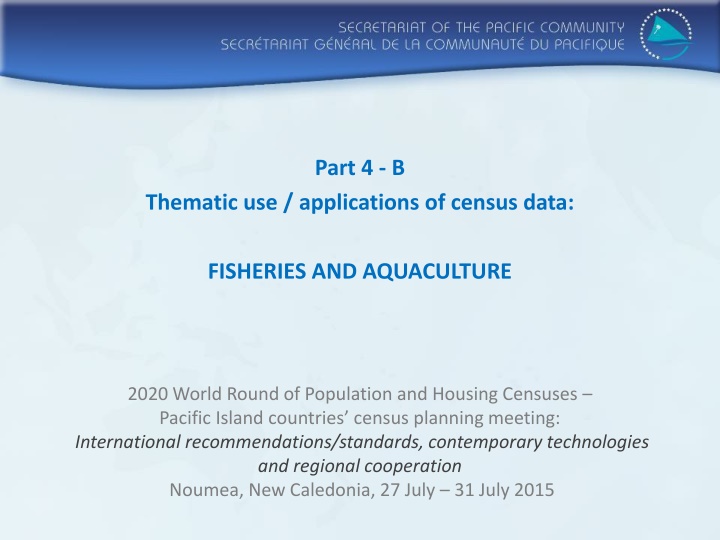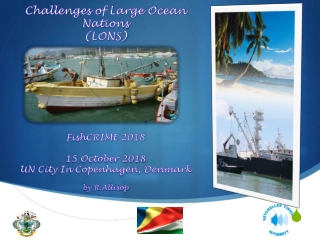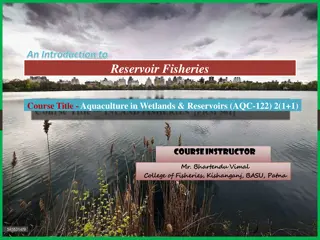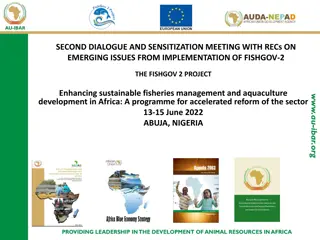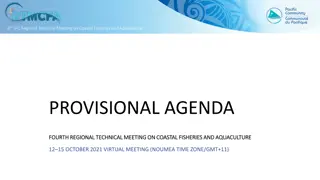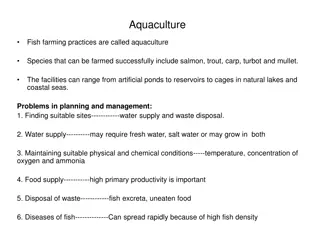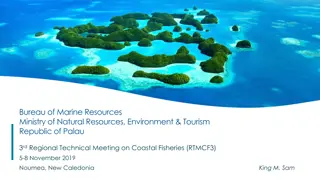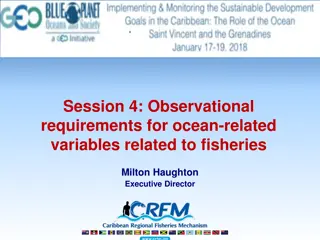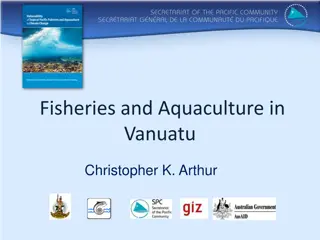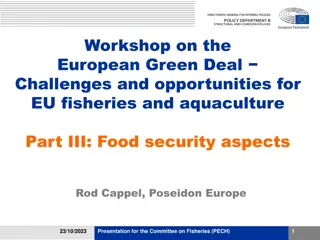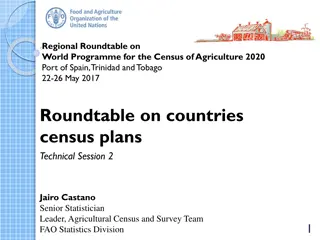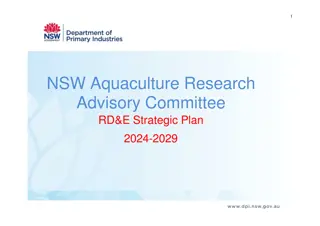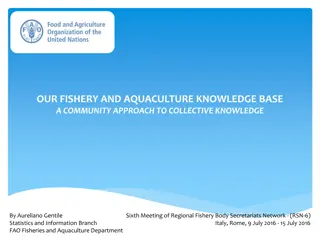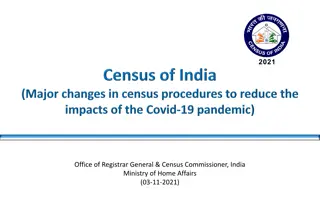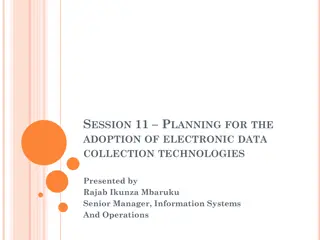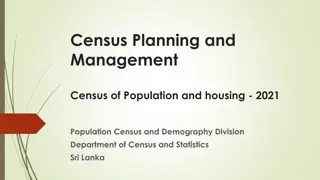Importance of Census Data in Fisheries and Aquaculture Planning
Fisheries and aquaculture play a vital role in food security, economy, and culture. Utilizing census data helps in policy development, resource management, and enhancing social and economic aspects of these sectors. The Global strategy emphasizes a multi-stage approach for improving agricultural and rural statistics through census frameworks.
Uploaded on Feb 25, 2025 | 2 Views
Download Presentation

Please find below an Image/Link to download the presentation.
The content on the website is provided AS IS for your information and personal use only. It may not be sold, licensed, or shared on other websites without obtaining consent from the author.If you encounter any issues during the download, it is possible that the publisher has removed the file from their server.
You are allowed to download the files provided on this website for personal or commercial use, subject to the condition that they are used lawfully. All files are the property of their respective owners.
The content on the website is provided AS IS for your information and personal use only. It may not be sold, licensed, or shared on other websites without obtaining consent from the author.
E N D
Presentation Transcript
Part 4 - B Thematic use / applications of census data: FISHERIES AND AQUACULTURE 2020 World Round of Population and Housing Censuses Pacific Island countries census planning meeting: International recommendations/standards, contemporary technologies and regional cooperation Noumea, New Caledonia, 27 July 31 July 2015
Contents Importance of fisheries and aquaculture Fisheries and aquaculture questions in past censuses Applications of census data in a fisheries and aquaculture context Global strategy fisheries and aquaculture statistics Proposed core fisheries and aquaculture module Proposed themes in supplemental fisheries and aquaculture modules The Benefish project Discussion
Fisheries and aquaculture are important Food security High per capita fish consumption Economic Important contribution to GDP (2007 estimates) Low estimate High estimate SSF Aquaculture Industrial 250 12% Per capital fish consumption (kg) 10% 200 Contribution to GDP (%) 8% 150 6% 100 4% 50 2% 0 0%
Fisheries and aquaculture questions in past censuses 90.0% Participation - household participating in fishing (and aquaculture) activities Equipment asset ownership Activity - type of fishing undertaken Income - income generated from sales Location - where fishing activity occurs Purpose - use of production Species - what species are targeted Expenditure household expenditure on fish for consumption Production - volume n = 43 80.0% Countries = 15 70.0% Proportion of censuses with questions 60.0% 50.0% 40.0% 30.0% 20.0% 10.0% 0.0%
Applications of census data in a fisheries and aquaculture context 1. 2. 3. Policy development (e.g., industrial vs small-scale) Development planning (e.g., FAD deployment; hatchery) Resource management (e.g., community based ecosystems approach to fisheries management; WCPFC) Social and economic (e.g., food use and security, livelihoods, cultural, poverty alleviation) Household listing for sample frames (statistical validity) 4. 5.
Global strategy to improve agricultural and rural statistics Guidelines to enhance fisheries and aquaculture statistics through a census framework multi stage approach: Step 1: census Step 2: community survey Step 3: household survey Define survey targets Engagement by scope Infrastructure Governance Common property Services Infrastructure Household and individual Production Trade Stocks balance sheet and resources Inputs Processing Prices Income and expenditure SUPPLEMENTARY CENSUS MODULE
Proposed core fisheries and aquaculture module 1. Has any member of this household engaged or participated in any fishing activities in the past 12-months? [Yes / No] a) Fishing capture / gleaning b) Aquaculture freshwater / mariculture c) Post harvest vendor / food processing / handicrafts d) Tourism guiding / agro / environmental e) Other (e.g., boat building) What was the main purpose of these activities? a) Subsistence (home consumption) b) Sale (income generation) c) Mainly home consumption, but some sale d) Mainly sale, but some home consumption e) Other What are your annual production estimates? AND/OR What are your annual income estimates? 2. 3.
Supplementary challenge: Fisheries and aquaculture are complex E.g., supplementary question E.g., pre-described categories S1: What type of fishery and aquaculture is this household involved in? Fishery / aquaculture type Y / N Tuna and other pelagic fish Deepwater fisheries Reef fish (excl. aquarium trade) Reef fish for aquarium trade Tuna and other pelagic fish Invertebrates for domestic supply Invertebrates for international markets (excl. sea cucumber) Reef fish (excl. aquarium trade) Sea cucumbers Invertebrates for domestic supply Freshwater aquaculture Marine aquaculture (incl. seaweed, clams, pearls) Freshwater aquaculture
Proposed themes in supplementary module With input from SPC s FAME division and based on recommendations made by the global strategy to improve agricultural and rural statistics, supplemental data items should cover: 1. Fishery / aquaculture industry detail 2. Output estimates 3. Trade by market 4. Assets and stocks balance sheet and natural resources 5. Inputs fishing effort (location, trips, time, gear) labour, ponds, feed, etc. 6. Post harvest vending, processing and value adding 7. Prices - producer and consumer 8. Legislation fisheries management, awareness, licensing, etc. 9. Infrastructure marketing, hatcheries, ice plants, transport, etc.
The benefish study In 2001 and 2008 SPC collaborated with ADB to produce reference manuals on fisheries in the economies of PICTs The publications brought together much of the available information on benefits from fisheries - total fish harvests, fisheries contribution to GDP, exports, government revenue and nutrition 2015 Benefish study begins in August and there is interest in information in relation to: Fishing contribution to GDP Fisheries imports/exports Fisheries related employment Fish consumption
Discussion Suitability of proposed core fisheries questions Suitability of proposed themes of supplementary fisheries module Cost-benefit of adding module or doing additional survey Reference period
